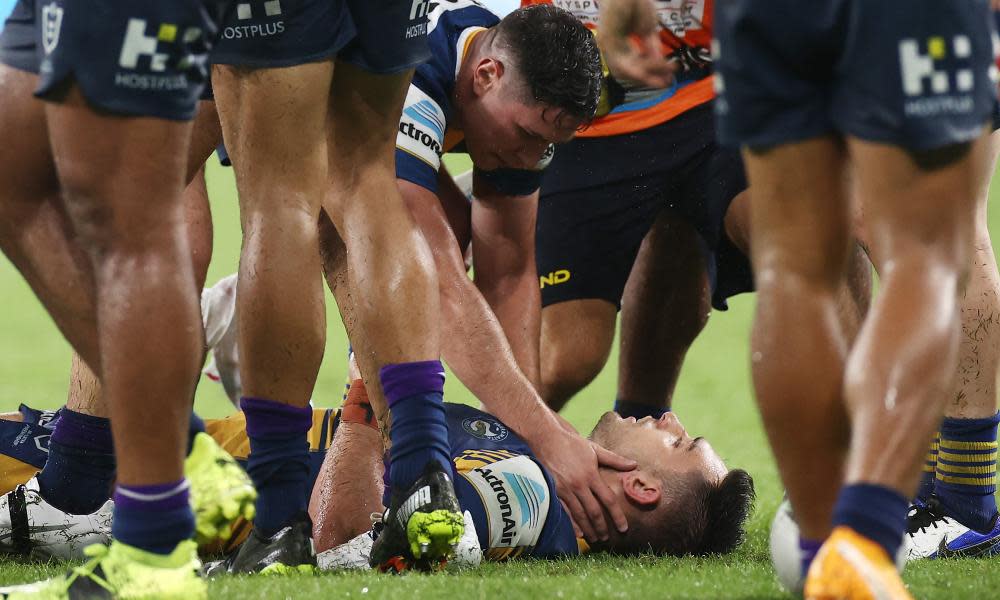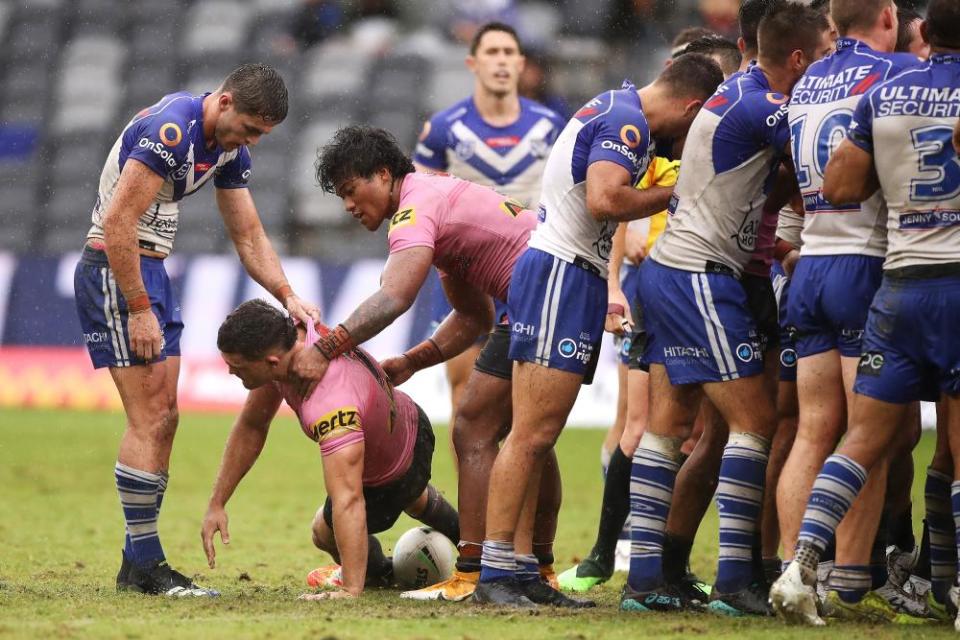Hidden toll on NRL players in spotlight after spate of head knocks

It has been a week since James Graham said he “privileged the present over the future” during his NRL playing days, despite the risk his numerous concussions could cause long-term illness.
And it has been almost that long since Graham’s St George Illawarra teammate, Josh Kerr, came out with this: “I know it might sound silly and a bit naive saying this, but I’d die for rugby league because [of] the people you meet, the places you go, the money you get paid ... you can’t do this forever.
“I think you’ve got to be willing to die to play this sport.”
Related: AFL approves medical substitute rule on eve of 2021 season
In the intervening five days since those comments, five players have been sent to the casualty ward with “concussion” next to their names. That is almost two-thirds of the total eight injuries sustained across round two.
This is undoubtedly significant, and has prompted criticism towards the NRL over a perceived lack of protection for vulnerable players and inconsistent use of the sin bin, along with calls for harsher on-the-spot penalties to deal with high shots.
But perhaps another critical point of focus should be how many dangerous brain injuries have been missed altogether.
Part of the problem is an under-reporting of symptoms by players. A January study conducted by the University of Melbourne and published in BMJ Open Sport and Exercise Medicine found almost 20% of 151 anonymously surveyed NRL players did not report a likely concussion to club medical staff.
But the picture is bigger – and also smaller.
The SCAT5, which includes immediate on-field testing by a trainer and subsequent off-field head injury assessment (HIA), does not test for subclinical concussions, which do not always present in the expected clinical way.
Despite the lack of signs or symptoms, research using biomarkers has found subclinical concussions also cause acute neurological deterioration, as was the case with the late former AFL player Shane Tuck. An autopsy found Tuck, who took his own life last year aged 38, had severe CTE.
Alan Pearce, an associate professor at La Trobe University and Victorian manager of the Australian Sports Brain Bank, said the SCAT5 was “not even close” to being exhaustive enough.
“We need to have some form of objective markers,” said Pearce, whose research focuses on techniques to quantify neural impairments in the weeks following concussion, and also the long-term outcomes following repeated concussions experienced by athletes over many years.
“Whether they’re blood markers, saliva markers or the brain stimulation technique that I use, which can be done in about 15 minutes in its most abbreviated form.
“There are plenty of things we can incorporate, but the consensus group that hold all the power want to hold onto their SCAT5 test, which many players have said they’ve manipulated.
Hot topic lately, so time for a concussion/HIA thread.
The testing that we see the trainer performing on field, & the “HIA” the player undergoes off the field is part of the Sports Concussion Assessment Tool, or SCAT5. A useful resource:https://t.co/9JNjlNFKtF pic.twitter.com/hBaJPKGKKN— NRL PHYSIO (@nrlphysio) November 13, 2020
“What we know about CTE is that it’s not necessarily just due to concussions but that significant repetitive impacts that don’t cause signs and symptoms of concussion certainly put athletes at risk. It’s those smaller impacts to the brain that can accumulate over time. We need to somehow address that and I’m not sure if we will be able to, but at least the sports will be able to acknowledge that’s a risk. At the moment they don’t acknowledge that.”
This yawning hole can be traced straight back to the Australian government’s top sporting agency. The NRL states that it supports the Concussion in Sport Australia position statement, which claims “there is currently no reliable evidence clearly linking sport-related concussion with chronic traumatic encephalopathy” and therefore “the link between sport-related concussion and CTE remains tenuous”.
To the contrary, only this month a coroner inquiring into Tuck’s death said research had shown a correlation between the “genuine risk of profound lifetime injury in a profit-motivated workplace, with a high turnover of young people and therefore a long aftermath trail for any consequences”.

The SCAT5’s shortfall is not an NRL-specific problem, given it is the standardised international tool for evaluating concussions in sport. But it does mean that, for instance, the HIA undertaken on Nathan Cleary on Saturday cannot comprehensively measure his risk level for long-lasting brain damage.
Furthermore, based on the latest research, doctors monitoring the Penrith captain in the coming days will not be able to determine with complete accuracy whether he will be fully recovered in time for Thursday’s grand-final rematch against Melbourne.
A Monash University study published in January found that, on average, concussed Australian rules footballers showed no ill symptoms after one week. However, analysis of their blood showed their brains had released elevated levels of the protein Neurofilament light (NfL), which is evidence of damaged brain cells. The paper’s author, Stuart McDonald, concluded that, because of those elevated NfL levels, some players may be returning before their brains have recovered.
In November, the NRL issued the NSWRL with a warning after an investigation into an HIA on Boyd Cordner found the Blues captain should not have cleared concussion protocols.
Cordner will miss the first half of this season because of his severe concussion history and now his Sydney Roosters co-captain, Jake Friend, is out after a heavy round-one collision with Manly forward Andrew Davey left the hooker convulsing. One day later St George Illawarra fullback, Matt Dufty, was knocked out after receiving a direct hit to the back of his head against Cronulla.
This past Thursday, Felise Kaufusi’s preposterous excuse for a tackle saw his elbow make heavy contact with the head of Ryan Matterson, who had to be helped from the field. And on Saturday, South Sydney lost skipper Adam Reynolds and winger Jaxson Paulo to HIAs and they did not return while Manly’s Cade Cust suffered the same fate.
Roosters coach Trent Robinson pondered the issue late last week, and wondered if Parramatta’s loss of Matterson in their win over the Storm warranted the introduction of a medical substitute like the one just implemented in the AFL.
“I haven’t landed on a spot, but I thought it was a very good example last night of when it possibly could be used,” Robinson said. “People want the attrition of our game and the hardness of our game, and we also need to protect the players.”
As it stands, the NRL requires players who suffer a concussion to sit out for 11 days unless they are cleared by an independent doctor. The NRL is also discussing the merits of EyeGuide technology similar to the Bio-Eye project recently adopted by the AFL.
But it will not yet match the AFL’s new mandatory 12-day stand-down period. Emerging research finds that recovery from concussion takes closer to 30 days.
If players are not able to protect themselves, it must be done for them. No person should be willing to die for any sport, nor risk lasting damage that diminishes their quality of life.

 Yahoo News
Yahoo News 
